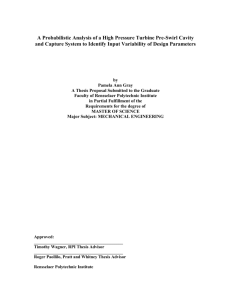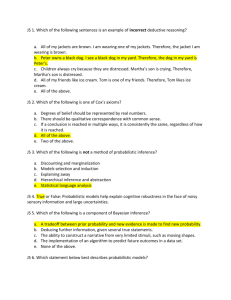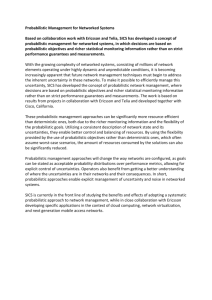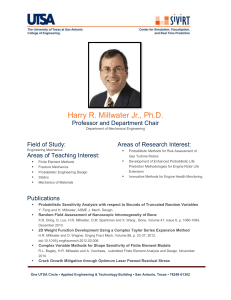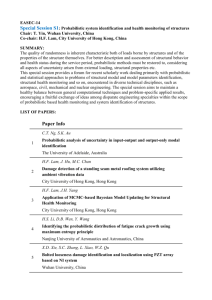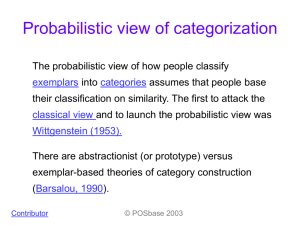Proposal for the Master Thesis
advertisement
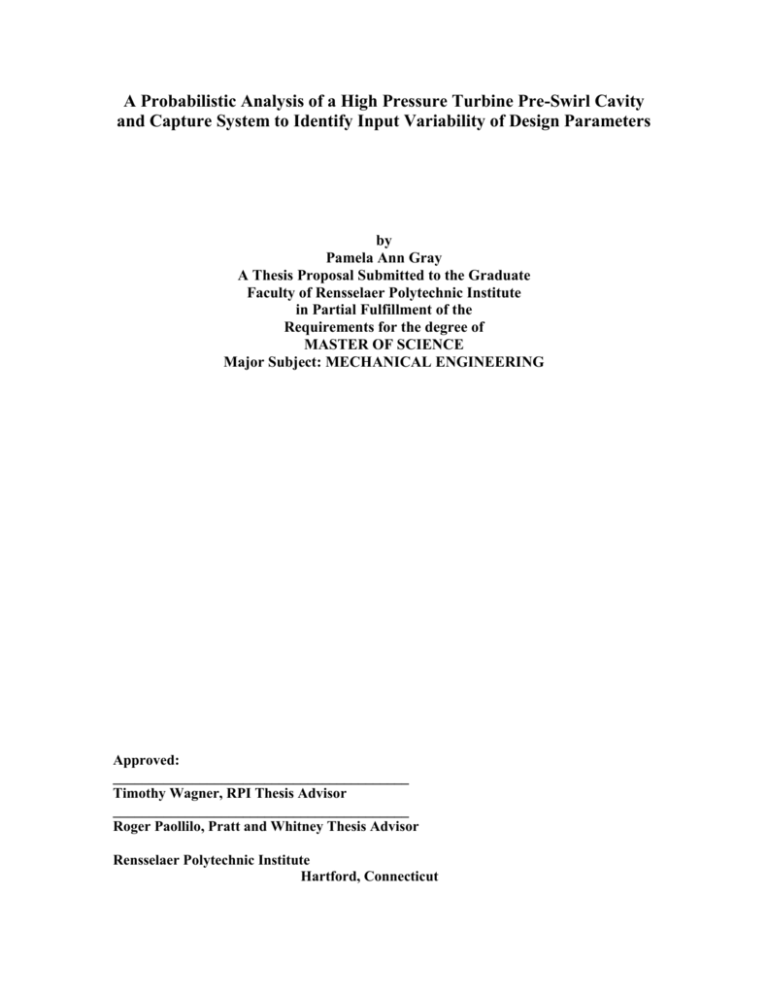
A Probabilistic Analysis of a High Pressure Turbine Pre-Swirl Cavity and Capture System to Identify Input Variability of Design Parameters by Pamela Ann Gray A Thesis Proposal Submitted to the Graduate Faculty of Rensselaer Polytechnic Institute in Partial Fulfillment of the Requirements for the degree of MASTER OF SCIENCE Major Subject: MECHANICAL ENGINEERING Approved: _________________________________________ Timothy Wagner, RPI Thesis Advisor _________________________________________ Roger Paollilo, Pratt and Whitney Thesis Advisor Rensselaer Polytechnic Institute Hartford, Connecticut Abstract: This paper will demonstrate a probabilistic study method that explores flow sensitivity of design parameters relative to the high pressure turbine single stage pre-swirl cooling air delivery and capture system of a turbofan engine. The goal of the proposed research is to identify the drivers of variability of the subsystem and determine the sensitivity of those drivers. Introduction: In the present study, the pre-swirl cooling air capture and delivery system of the high pressure turbine turbofan engine is analyzed by means of a probabilistic analysis. The flow system is currently modeled mathematically using a computer program which is a proprietary one dimensional secondary flow network solver. The program consists of a series of interconnected chambers and restrictors. The mathematical model of the internal flow system is created using exact values for the inputs. The outputs of the secondary flow model include but are not limited to mass flow rates, pressures, and temperatures and bearing loads, which are exact solutions. In order to better understand the significant design parameters of the pre-swirl cooling air capture and delivery system, a probabilistic approach is developed and propagated through the proprietary 1-D flow network solver. Probabilistic analysis methods such as Monte Carlo, Latin hypercube and others use a distribution of probable values rather than single values. A probabilistic analysis allows variation of different input parameters (many at a time) in a random manner independently which will generate the effect on several other output parameters with the resulting probability or frequency distribution of each output parameter. Review of previous work in the field indicates that there has been some work done regarding probabilistic studies of secondary flow system’s sensitivity impacts on; overall turbine cooling air system and bearing loads (Latin hypercube analysis) [2], metal temperatures (Latin hypercube analysis) [3], and oxidation lifing (Monte Carlo analysis) [1]. Unlike previous studies the proposed research uses the Latin hypercube probabilistic method to determine which design parameters of the pre-swirl cooling air capture and delivery system of the high pressure turbine system’s have the largest impact on mass flow rate and pressure. In addition to that the sensitivity of the significant drivers will also be identified. Problem Statement: The proposed research will investigate a subsystem of the secondary flow system using the Latin hypercube analysis. The subsystem being analyzed is the pre-swirl capture and cooling air delivery system of the high pressure turbine’s first stage. The results of the analysis will be used to determine which of the subsystems’ design parameters have a significant impact and what their variability is relative to the cooling air supply pressure and flow rate. Methodology: The steps will be used for setting up the probabilistic model inputs and outputs. Step 1: Analytical Flow Model Definition. Determine secondary flow model used to propagate the probabilistic equations. A datamatched secondary flow model of a current production commercial turbofan engine configuration was identified. The convergence criteria for the flow network solver is to solve all the unknown pressures, flows and temperatures until all the mass flow rates summed are equal to zero. This flow model’s input parameters are a specified pressure, temperature and flow rate for a standard day take off condition. Step 2: Determine the variation that will be applied to all selected inputs. Engine to engine variation by means of manufacturing tolerances will be varied. First probabilistic run assumed a 5% standard deviation on restrictor areas, a 15% standard variation on lab seals average clearances and a 25% standard deviation on the plat-form leakage areas, which are consistent with average manufacturing tolerances. Output parameters include flow rates, pressures and temperatures for the pre-swirl nozzle and the blade. The following table provides a list of selected output parameters of the subsystem. Step 3: Modify steady state secondary flow model to accept probabilistic input by creating an input file that contains the input parameter name (same as identified in flow model), nominal value, deviation, and distribution type. The flow network solver will then generate random values for each input within the given distributions and solve the system for each sample. The convergence criteria for the flow network solver is to solve all the unknown pressures, flows and temperatures until all the mass flow rates summed are equal to zero. This flow model’s input parameters are a specified pressure, temperature and flow rate at a take off condition Step 4: Review output data from first run to identify parameters that have largest impact on system. Identify manufacturing tolerances for each significant input by interrogating current build of material drawings for the hardware such as the knife edge seal clearances. Identify the blade cooling flow variation the durability engineers use for design, etc. The variation values are currently documented and can be found on drawings and engineering standard work. The standard deviation applied to the engine performance was obtained from performance engineers. Step 5: Modify probabilistic input file with updated deviation information for the input parameters that were identified as significant drivers, while keeping the previously defined deviations the same and re-run flow solver. The following table provides the parameters varied and the deviation applied for the revised second probabilistic run. Parameter TOBI OD Seal Standard deviation applied for second run =15% of Clearance TOBI ID Seal = 5% of Area Platform Seals = 25% of Area TOBI = 1.5% of Area Vortices = 5% of RPMF Blade Cooling = 6% of Area Pressures = 0.2% of P4-P5 Step 6: Post-process the output data to determine the variability of the output parameters. Goal: The intention of the research proposed is to develop a method to run a probabilistic analysis that will identify significant drivers of variability of the pre-swirl cooling air capture and delivery system of the turbofan engine and the sensitivity of those drivers. The set up of the probabilistic analysis will be identified to determine which of the design parameters have the largest impact on the system. This will be accomplished by using standard deviations consistent with average manufacturing tolerances. Once the significant drivers are identified then a refined analysis will be done using specific deviations based on specific manufacturing tolerances. Current manufacturing tolerances are based on state of the art machining practices. Further analyses based on any findings from this proposed research would be required to investigate whether or not modifying current limits would be a benefit to the manufacturing process. Tentative Thesis Milestones: (October 20) Complete literature and analytical model review of commercial 1-D deterministic flow models and develop probabilistic model input file draft. Run initial probabilistic model. (October 21) Provide reference material to advisor. (October 26) Create draft intro/background. (November 15th) Submit draft proposal, revised intro/background. (November 18) Identify input parameters and variability, and output parameters to be included in final analysis. Create final input file for probabilistic analysis. Run probabilistic model. Identify main drivers of variability and compare to first pass. Revise inputs/outputs if necessary. (November 26) Create draft analysis portion of thesis. (November 30) First completed draft submitted. (December 11) Submit approved Thesis. References: [1] Sidvell, V., Darmofal, D., 2003. “Probabilistic Analysis of a Turbine Cooling Air Supply System: The Effect on Airfoil Oxidation Life,” ASME Paper GT2003-38119. [2] Stearns, E., Cloud, D., 2004. “Probabilistic Analysis of a Turbofan Secondary Flow System, “ASME Pater GT2004-53197. [3] Stearns, E., Filburn, T., Cloud, D., 2006. “Probabilistic Thermal Analysis of Gas Turbine Internal Hardware, “ ASME Paper GT2006-90881. [4] Jarzombek, K., Dohmen, H. J., Benra, F.-K., Schneider, O., 2006. “Flow Analysis in Gas Turbine Pre-Swirl Cooling Air Systems – Variation of Geometric Parameters,” ASME Paper 2006-90445. [5] United Technology Corporation, Reprinted with revisions in 1988, The Aircraft Gas Turbine Engine and It’s Operation. Pratt and Whitney Operating Instructions 200. [6] Kerrebrock, J.L., 1992, Aircraft Engines and Gas Turbines, The MIT Press, Cambridge. [7] Alexiou, A., Mathioudakis, K., 2009. “Secondary Air System Component Modeling for Engine Performance Simulations, “ ASME Journal of Engineering for Gas Turbines and Power, 131. pp. 031202-1 – 031202-9.
